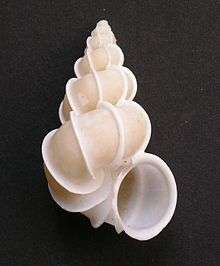Johan de la Faille
_-_Portrait_of_Johan_de_la_Faille_-_WGA24594.jpg)
_-_Portrait_of_Margaretha_Delff%2C_Wife_of_Johan_de_la_Faille_-_WGA24595.jpg)
Johan de la Faille (1626 or 26 December 1628 – 14 October 1713) was a member of the vroedschap in Delft. As a supporter of prince William III of Orange, he was appointed in 1672, the Year of Disaster after the First Stadtholderless Period, when the Dutch Republic was in danger.
Johan de la Faille was the owner of a famous curiosity cabinet, which was started by his grandfather and father, mainly of sea shells,[1] including a specimen of the precious wentletrap Epitonium scalare[2] and the cone shell Conus cedonulli,[3] as well as birds, Roman coins and medals, porcelain, tapestries and paintings.
Life
The family De la Faille or Della Faille has its origin in Antwerp, some say in Naples and traded on the Levant already in 1540.[4] The family split when around 1585 some members emigrated to the North of the Netherlands, c.q. Haarlem, Dordrecht, or Leiden, while they became protestant. His father was Barnardus la Faille living in Den Haag, a sort of accountant for the stadholder Maurice of Orange. He had married in 1618 with Elisabet Camerling, living in Delft.[5]

Very little is known of Johan's life, he probably studied law, and visited France and Italy (1667). Johan married on 28 January 1671 with Anna (Margaretha) Delff, (1647–1715). The couple had four children: Johan Bernard, Cornelis, Abraham and Elisabeth.[6] He was bailiff in Delft between 1680 and 1713.
References
- ↑ http://www.codart.nl/exhibitions/details/373/
- ↑ http://penelope.uchicago.edu/~grout/encyclopaedia_romana/aconite/wentletrap.html
- ↑ http://penelope.uchicago.edu/~grout/encyclopaedia_romana/aconite/cedonulli.html
- ↑ Trading places: the Netherlandish merchants in early modern Venice. By Maartje van Gelder
- ↑ http://dare.uva.nl/document/139407
- ↑ http://www.archief.delft.nl/